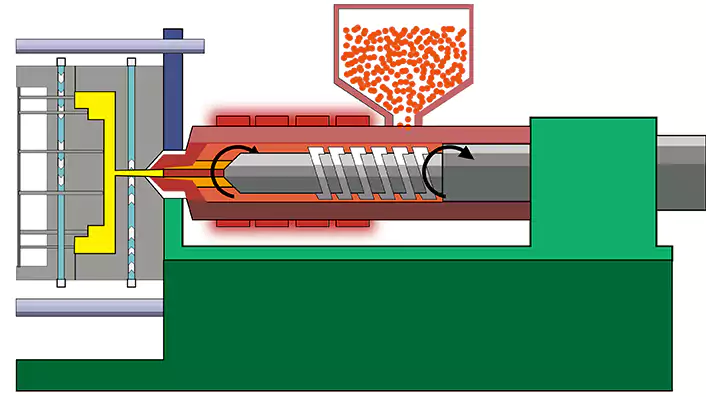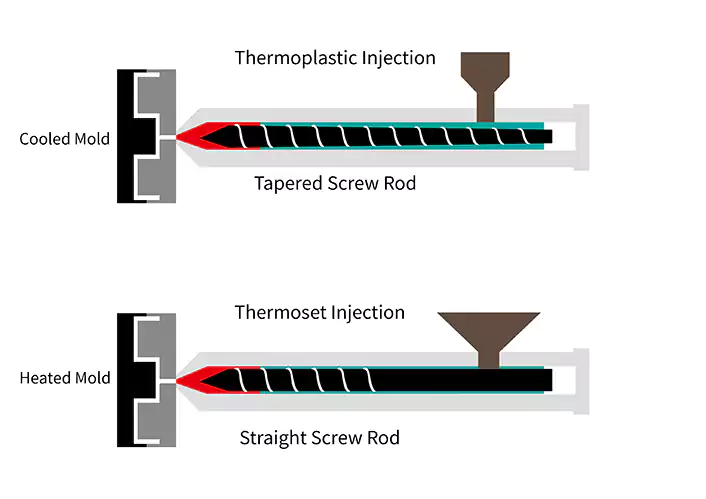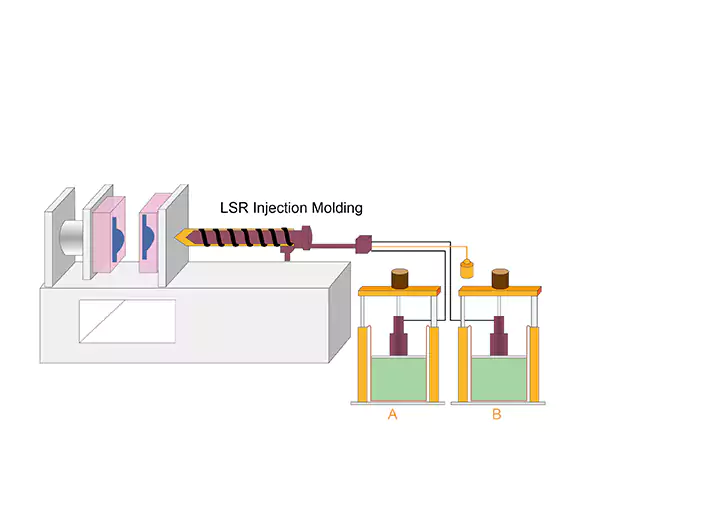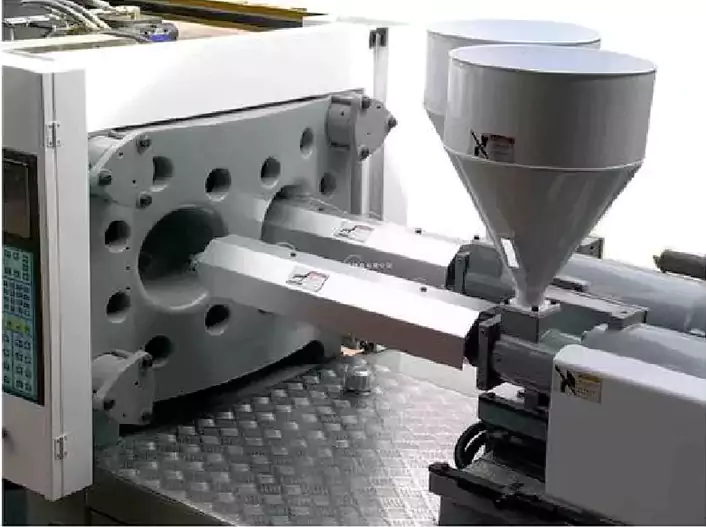Top 5 Widely Used Plastic Injection Molding Types
Plastic components are widely used in various industries, including automobiles, household appliances, and medical devices. Plastic injection molding is a versatile and cost-effective method of creating plastic components that offers several advantages over other plastic molding technologies. In this article, we will explore the top 5 widely used plastic injection molding types, including their advantages and disadvantages.
What is plastic injection molding?

Plastic injection molding is a manufacturing process used to produce a wide range of plastic parts and products. The process involves melting plastic resin pellets and injecting them into a pre-made mold under high pressure. Once the plastic cools and solidifies, the mold is opened, and the finished part is ejected. The primary components for this process include an injection molding machine, a mold, and raw plastic materials.
The plastic injection molding process is valued by manufacturers for producing high-quality parts in a wide range of shapes, sizes, and complexities. It is commonly used in industries such as automotive, medical, consumer goods, and electronics, among others.
1. Thermoplastic Injection Molding
As the name suggests, a thermoplastic is a plastic that becomes more malleable (turns into a liquid) when heated. Thermoplastic injection molding is the most commonly used type of plastic injection molding. It uses thermoplastic material, to melt the material to liquid and inject it into a pre-made mold to manufacture completely functional parts. It uses thermoplastics such as polypropylene (PP), polyethylene (PE), nylon (PA), and acrylics for the production of parts and components.
Advantages of Thermoplastic Injection Molding
Accuracy: Thermoplastic injection molded parts can be created with pinpoint accuracy, giving them a significant edge over alternative technologies such as 3D printing.
Surface Finish: A wide range of general and engineering-grade resins may be used in thermoplastic injection molding. The method can also produce parts with flawless surface finishes, making the production process suitable for both prototypes, low, and high-volume production runs.
Complex Shapes: This type of injection molding can produce high-complexity parts, parts can take any shape that the molten plastic can flow to.
Material is Reusable: Thermoplastics can be molded multiple times. Recycled plastic can still melt and be made into products when heated. It should be noted that products made of recycled plastic will be more brittle and hard. Therefore, the proportion of recycled plastics that can be added to products needs to be strictly controlled so as not to affect product quality.
Disadvantages of Thermoplastic Injection Molding
Cost: The tooling and time required to create the plastic injection mold are costly, making it an expensive process. And when the total production volume is low, the process becomes noticeably expensive per product.
Flaws: The thermoplastic injection molding requires high temperatures for the plastic to melt properly, which can cause warping or distortion in the finished product.
2. Thermoset Injection Molding
As the name suggested, thermoset material becomes ‘set’, or solid when heated. Thermoset molding is an irreversible molding procedure that involves forcing pliable forms of thermoset plastic into a heated mold and shaping them into their final shape. It uses thermosetting plastics such as epoxy resins or phenolic resins for the production of parts and components. Thermoplastic molding is the process of injecting hot material into a cold mold. Thermoset plastic molding is the process of injecting soft material into a hot mold. The plastic material is then cured and keeps the part’s final form.

Advantages of Thermoset Injection Molding
Strength: Thermoset injection molding offers superior strength and durability compared to thermoplastics due to its chemical properties. After curing, thermoset plastic does not become soft when the temperature increases.
High-volume runs: Thermoset injection molding is excellent for high-volume runs, and it produces precision and little waste. Injection-molded products have less waste material than other methods due to the particular tooling and material mix.
Disadvantages of Thermoset Injection Molding
Tooling expenses: Compare with other thermoset plastic forming methods such as compression molding or transfer molding, the cost of tooling for thermoset injection molding is much higher. This can increase the overall cost of production.
Material not recyclable: The cured thermoset plastic can not be injected again. The curing process is an irreversible process. Therefore, thermoset plastic is not recyclable. This potentially increases the material cost.
Part size: For thermoset material, the size of the part being formed is an important factor in the molding process. Smaller pieces (0.1 to 6 lbs) are typically injection molded, whereas bigger parts are transfer or compression molded. The magnitude of the order will also determine which molding method is most suited to the project. Compression molding would most likely be utilized for bigger components with a low (or high) volume, whereas transfer molding would be used for projects with a medium to high volume. For big-volume runs with smaller items, injection molding would be suitable.
3. Liquid silicone injection molding

Liquid Silicone Rubber (LSR) molding, also known as Liquid Injection Molding (LIM), is a thermoset method that involves mixing two liquid compounds that are then heat-cured inside the mold using a platinum catalyst to produce flexible silicone components. LSR moldings are sturdy and appropriate for difficult applications because of their low compression set and ability to withstand severe temperatures. LSR elastomer provides great optical clarity, durability, and design freedom while retaining good mechanical qualities across a wide temperature range (-50 to 250 C).
Advantages of Liquid Silicone Injection Molding
Design and tooling flexibility: LSR injection molding is excellent for creating intricate geometries and may incorporate many functional aspects into a single product.
Low viscosity: Because of its design and tooling flexibility, the substance will flow smoothly into thin and complicated sections of the mold.
Compatibility with human tissue and bodily fluids: LSR is suitable for medical and healthcare items due to its sterilizability and excellent compatibility with human tissue and bodily fluids.
Mechanical properties: LSR has excellent mechanical properties, including strong tensile strength, good elongation, and a wide hardness range (5-80 Shore A).
Disadvantages of Liquid Silicone Injection Molding
Cannot be recycled: Once LSR has cured, it cannot be molded again and thus cannot be recycled.
Production time and expense: Production time and expense are both lengthy.
Sticky feel: If left untreated, LSR has a sticky feel that attracts dust and other debris.
Not appropriate for submerged applications: LSR is not appropriate for submerged applications in alcohol or petrol.
Limited grades: Silicone comes in a restricted number of grades for the LIM process.
4. Multi-shot Injection Molding
Multi-shot plastic injection molding is the practice of concurrently injecting two or more plastic materials or colors into a single mold to make a single part or component. This method offers several advantages over traditional single-shot injection molding.

Advantages of Multi-shot Injection Molding
Reduced assembly time and cost: Multi-shot injection molding produces parts with multiple materials or colors in a single step, reducing the need for assembly and lowering production costs. It also saves costs by avoiding secondary operations such as painting or coating processes.
Improved part quality: Multi-shot injection molding produces plastic parts with improved quality and functionality by combining materials with different properties, such as hardness, flexibility, and color.
Enhanced design flexibility: Multi-shot injection molding allows for greater design flexibility by enabling the creation of complex parts with multiple materials or colors in a single mold.
Reduced waste: Multi-shot injection molding can reduce waste by producing parts with precise material placement and reducing the need for secondary operations.
Increased production efficiency: Multi-shot injection molding can increase production efficiency by reducing cycle time and improving part consistency.
Disadvantages of Multi-shot Injection Molding
Long Setup lead times and high tooling costs: The initial expenses are significant due to the required design, testing, and tooling. The setup time can be rather long due to the intricacy of the tooling and the need to clear the molding machine of all prior material before the next product can be created.
Part design constraints: Plastic components must be developed with injection molding in mind and must adhere to the fundamental injection molding criteria.
Small runs of parts can be expensive: Limited batches of components have long been regarded to be prohibitively expensive to injection mold.
Higher Machinery Cost: The multi-shot injection molding needs a kind of specialized injection molding machine. It needs to have multi barrels and multi hoppers. The machinery cost a lot more than traditional injection machines.
5. Gas-assisted Injection Molding

Gas-Assisted Injection Molding (GAIM) is a way to make parts and components that have very detailed or complex shapes without getting warped during the cooling process. This is done by injecting nitrogen gas into hollow sections of the part while it cools down after being made. This method is better than traditional methods because it saves time and money by not needing to do as much trimming or other extra work after the part is made. However, it requires expensive machines to use.
Advantages of Gas-assisted Injection Molding:
Reduced material usage: Create hollow parts with thicker walls, resulting in cost savings.
Improved part quality: Reduce warpage, sink marks, and other defects that can occur during the injection molding process.
Increased design flexibility: Allow for the production of parts with complex geometries and varying wall thicknesses.
Reduced cycle time: Faster cooling of the part increases production efficiency.
Reduced weight: Reduce the weight of parts by creating hollow cavities within the part, which can result in cost savings and improved part performance.
Disadvantages of Gas-assisted Injection Molding:
Higher initial cost: GAIM requires specialized equipment and tooling, which can result in higher initial costs compared to traditional injection molding.
Limited material options: Limited to certain types of thermoplastic materials, which may not be suitable for all applications.
Increased complexity: GAIM is a more complex molding process compared to traditional injection molding, which can result in longer production times and increased maintenance requirements.
Limited wall thickness: GAIM is limited in the minimum wall thickness that can be achieved, which may not be suitable for all applications.
Environmental concerns: GAIM can have environmental concerns due to the use of pressurized gas and the disposal of waste materials.
Benefits of plastic injection molding
For a multitude of reasons, plastic injection molding is the most extensively used component production technique, including:
1. High Production Efficiency
One of the main advantages of plastic injection molding is its high production efficiency. The process is extremely fast, and the high production output rate makes it even more efficient and cost-effective. Each cycle lasts only approximately 15-120 seconds with varied speeds.
2. Design Complicated Parts
Injection molding can handle exceedingly complicated pieces and has the potential to produce millions of almost identical parts. Key design elements should be considered to maximize the effectiveness of high-volume injection molding and the precision and quality of your parts.
3. Increased Strength
When designing a plastic injection molded part, one of the most important factors to consider is strength. The designer should be familiar with flexibility in order to alter the integrating ribs. We must understand how the user will use the part and the environment to which it will be exposed.
4. Material and color flexibility
Choosing the right material and color for a project are two of the most critical parts of producing plastic components. Because of the wide range of both, the options are practically unlimited.
5. Waste Reduction
Companies’ green manufacturing initiatives are important to consider because they demonstrate a commitment to quality, sustainability, and optimal safety. The molding process produces excess plastic. Look for a business that has a mechanism in place to recycle its leftover plastic.
6. Reasonably Low Labour Costs
In comparison to other types of molding, labor costs in plastic injection molding are typically low. The capacity to create parts at a high level and at a high production rate contributes to its cost efficiency and effectiveness.
Work with Capable Machining for your next injection molding project
When it comes to plastic injection molding, having a professional manufacturing company is essential to ensure the success of your project. Capable Machining specializes in providing high-quality injection molding services to a wide range of industries. It can help you optimize your mold design, select the right plastic material, and produce custom molded parts with high quality that meet your specifications.
Capable Machining has expertise in raw material selection. They can help you select the right materials for your plastic injection molding project based on your specific requirements and budget. They have experience working with a wide range of thermoplastic materials, including acrylonitrile butadiene styrene (ABS), polycarbonate, nylon, and more, with the right choice of plastic injection molding process.
One comment
Leave a Comment
You must be logged in to post a comment.
Hello there! I could have sworn I’ve visited your blog before
buut after looking at a few of the articles I realized it’s new to me.
Regardless, I’m definitely pleased I came across it and
I’ll be book-marking it and checking back frequently! /